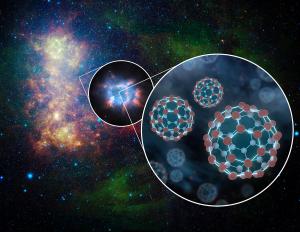Post
Catalytic Converter
23 July 2012
 NASA/JPL-Caltech/T. Pyle
NASA/JPL-Caltech/T. PyleOne of the exciting aspects of astrophysics (and any area of science really) is how odd discoveries lead to new understanding. As a case in point, consider our understanding of the gas and dust in our galaxy. Gas and dust is often seen as an annoyance because it gets in our way. Observational astronomy would be much easier if it weren’t for all the gas and dust. Sure, gas clouds will sometimes collapse to form new stars, but beyond that it surely wasn’t doing anything interesting.
It was long thought that the gas and dust in the galaxy was largely inert. Occasionally a couple of atoms might collide and bond, but if by some change a molecule larger than two atoms were to form it would quickly be broken apart by the ultraviolet light from nearby stars. Besides, deep space is really cold (about 3K) so there isn’t enough heat to drive any real chemistry.
As radio astronomy developed, however, we starting observing interstellar clouds containing larger molecules such as water, methane and alcohols. More recently infrared observations have observed hydrocarbon gases. It would seem that interstellar clouds contained far more than simple diatomic molecules.
Since these complex molecules are located in large gas and dust clouds, they are protected from the ultraviolet radiation that would break them apart. But that didn’t explain how they formed in the first place. Even given the fact that molecular clouds are somewhat warmer (about 10K) and denser, the random collisions of gas molecules isn’t enough to create the range and quantity of complex molecules we observe. Something else must be driving their creation.
What we now know is that molecular clouds have a catalytic converter. The catalytic converter in your car consists of some type of catalyst (typically platinum) applied thinly over a large surface area. Having lots of surface area is key, because your catalytic converter relies on surface physics. Basically when chemical reactions happen on a surface they are constrained a thin layer on the top of the surface. This means you can get chemical reactions that are faster and more complex. This surface chemistry is necessary for your catalytic converter to be effective.
In interstellar clouds the surfaces of dust particles act as a catalytic converter. Sometimes atoms and molecules collide with a dust particle and get trapped on its surface. As more molecules get trapped they can interact in complex ways, which can create the complex molecules we see.
So we now know that interstellar clouds are far from inert. A complex chemical dance occurs between their dusts and gasses, and we are only beginning to understand it.